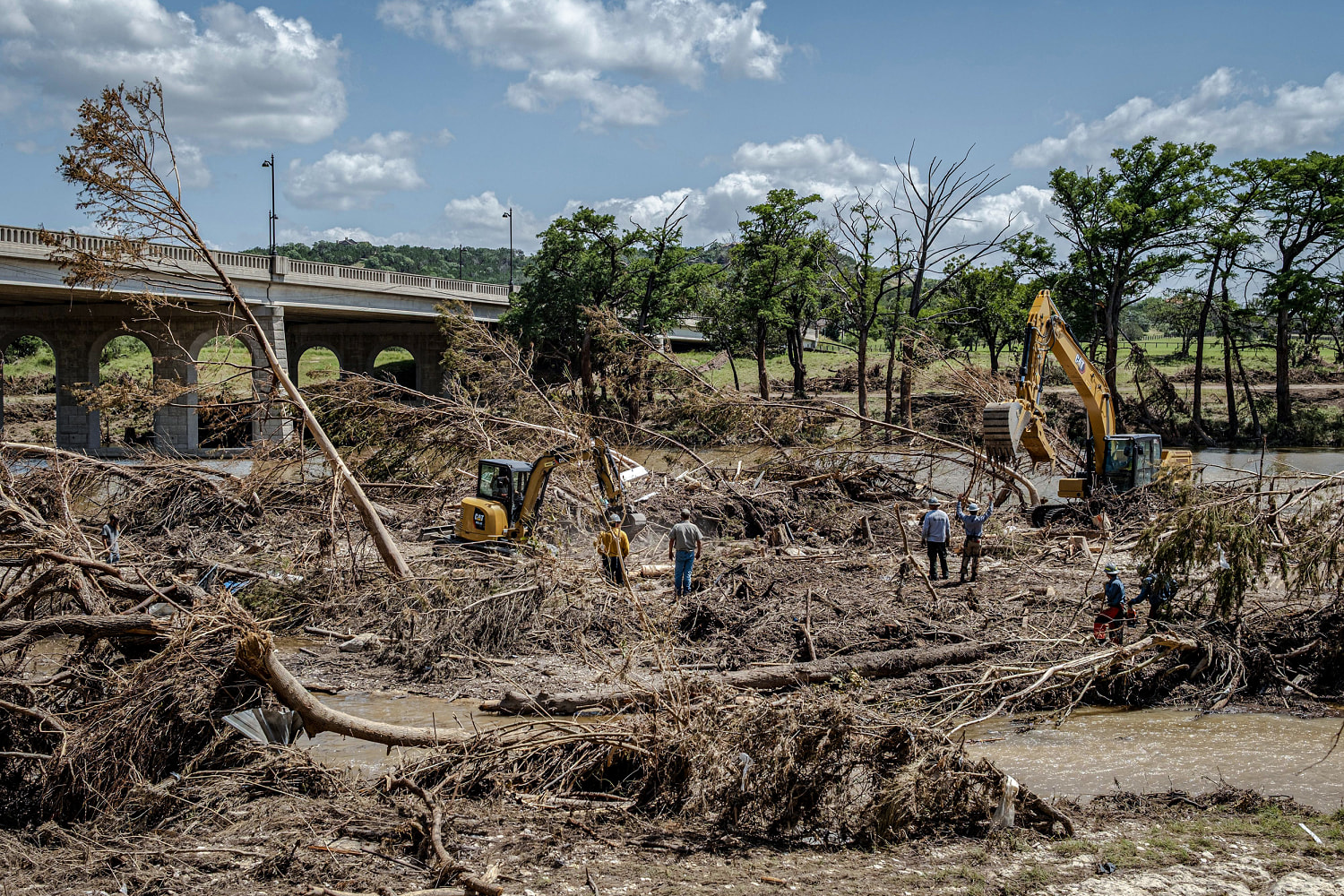

INGRAM, Texas — Officials in this small city that was hit hard by the July 4 floods have urgent questions for their county’s emergency management coordinator.
Where was William “Dub” Thomas when the National Weather Service sent out its first flash flood warning at 1:14 a.m.? Who was coordinating the response in those critical hours when first responders and volunteer firefighters were alerting one another over radio about the rising waters? And what is Thomas, who oversees emergency planning in Kerr County, doing to protect them from the next flood?
Ingram’s leaders thought they could finally get answers more than two weeks after the floods Monday night at a City Council meeting, which would have been the first time Thomas addressed the catastrophe publicly. Instead, Thomas canceled his appearance, citing a scheduling conflict.
“We have no information,” Mayor Claud Jordan told those who attended the meeting. “Nobody’s called us. We were hoping to hear from [Thomas], but I guess not.”
Ingram, a city of about 1,800 people that swells each summer with visitors to its campgrounds and RV parks along the Guadalupe River, does not have its own emergency management operations and relies on Thomas to oversee its emergency management plan. The growing questions came as residents are in the thick of cleanup and filing for federal assistance, and first responders are moving away from recovery operations after a disaster that killed more than 130 people across the Texas Hill Country.
As the Guadalupe River rose in the early hours of July 4, residents and visitors scrambled to evacuate without any definitive guidance from the county. Floodwaters swept away more than two dozen homes at the Blue Oak RV Park near Ingram, where a 30-foot wall of water engulfed them in 40 minutes, owner Lorena Guillén said. Guillén described seeing trailers tearing up from the ground and plunging into the river. Her husband spotted a man holding babies in the rushing water and tried to save them. But the current overpowered them, and they were swept away.
Ingram officials have told NBC News that no one from the county communicated with them about the emergency response or whether to evacuate after the National Weather Service sent out its 1:14 a.m. flash flood warning.
“Why weren’t we notified?” council member Rocky Hawkins asked.
County officials have provided few details about communication and coordination in the lead-up to the flooding and in the hours when the Guadalupe River and its creeks rose to record levels. Officials have said their primary focus was on search-and-rescue efforts, and Kerr County Sheriff Larry Leitha assured the public that there would be an “after-action” review of what happened July 4. His office said Wednesday that it remains in response and recovery operations and that a review has yet to be conducted.
Thomas, who has been the county’s top emergency coordinator since 2015, did not respond to requests for comment.
Jordan said he would have welcomed a call to say, “Get up! Your town’s flooding.”
“Why didn’t somebody call me at 1:30?” he asked. “Why didn’t Dub Thomas call me at 1:30?”
Responding to the chaos
Jordan, Ingram’s mayor, said he was unaware of any communication between his city and the county on July 3, ahead of the holiday weekend and the forecast rains.
And Diana Baccus, Ingram’s volunteer fire chief, said she was not in communication with anyone from the county on July 4. “I’ve only spoken to Dub Thomas one time during this entire thing,” she said. They had a conversation days after the flooding about the changes to the river.
Her experience in the early morning of July 4 was haphazard as calls came in over the radio that streets were flooded and firefighters elsewhere were suddenly asking for Ingram’s help at the Blue Oak RV Park, where emergency responders began arriving around 4 a.m.
“We were just moving,” Baccus said as her team undertook rescues at the low-lying RV parks were people had to be roused from bed. “I’m like, ‘Grab your children, get your stuff, get your pets and go.’”
Other fire and rescue officials in Ingram and surrounding unincorporated areas also said their focus, upon learning of the flooding, was trying to save lives as other departments began radioing in for help.
In Hunt, an unincorporated area near Ingram brimming with summer camps along the river, at least 27 young campers and staff members died at the all-girls’ Camp Mystic after floodwaters overtook cabins.
Lee Pool, the chief of the volunteer fire department in Hunt, said that from 3 to 3:30 a.m., he was in bed at home listening to radio chatter when he heard “flood,” which prompted him to jump into clothes and start heading west on Highway 39 to get to the fire station.
By that time, the water had already risen to dangerous levels. Pool said he made it as far as Schumacher Crossing, saw that it was impassable and called in to county dispatch to confirm that the river was flooding. The water was rushing in, trapping his vehicle. He said he abandoned it for higher ground, estimating it was 4:15 a.m. to 4:30 a.m. when he was in a safe spot.
Protocol in emergency situations
County officials had at least two ways to alert their community that they faced an impending catastrophe: CodeRed, which cellphone users can opt in to receiving, and the Integrated Public Alert & Warning System, or IPAWS, which is similar to an Amber Alert.
The National Weather Service used IPAWS to send a flash flood warning alert to cellphones at 1:14 a.m. and then again at 4:03 a.m. describing a flash flood emergency.
However, IPAWS data examined by NBC News and NBC affiliate KXAN of Austin does not indicate Kerr County used the system to issue its own alert, such as one that could have ordered evacuations. The first alert the county issued through IPAWS was on July 6 about the “high probability” of renewed river flooding, according to IPAWS data.
Data also shows some people did get CodeRed alerts from Kerr County on July 4, although they were versions of the National Weather Service warning and were received inconsistently. Some officials said they got no alerts at all, and one official in Kerrville has told NBC News that “CodeRed was not on our mind” while they were conducting evacuations around 5 a.m.
Whether emergency alerts on July 4 would have been received on all phones is unclear. Spotty cell service or none at all is not uncommon in parts of Kerr County, northwest of San Antonio.
Joe Arellano, who worked more than two decades as a meteorologist at the National Weather Service before he retired from its Austin/San Antonio office in 2021, said that disaster scenarios can always be chaotic and that it’s unknown whether sending further warning or evacuation alerts would have made a difference.
“The night of July 4 was just a recipe for catastrophic flooding in that area,” Arellano said. “But that doesn’t mean actions couldn’t be taken.”
Arellano noted that the lead time on the initial flash flood warning was over an hour, which is “excellent as far as warnings go for flooding.”
Arellano said that during his time in the National Weather Service office, ahead of a pending emergency, such as severe rain and flooding, meteorologists would arrange conference calls with all the affected counties, including with top officials and emergency managers. The Department of Homeland Security noted on X that such a briefing took place on July 3, but it’s unclear who attended and whether a representative from Kerr County was on the call.
Arellano said the National Weather Service would be in contact with county emergency management officials so they understood the potential severity of any weather event. Some counties may have staffing overnight to monitor and communicate with the office.
The office also started a National Weather Service online “chat” before Arellano left his role as a way to communicate with the emergency managers and public officials during any event.
Arellano said it’s crucial for weather forecasters and government officials to be in constant communication as they decide how best to notify the public about potentially dangerous and life-threatening events. It’s unclear what communication there was between the National Weather Service and Kerr County before and during the flooding.
“The Weather Service could be putting out hundreds of warnings, but if they’re not getting out and people are not taking actions, what’s the worth of the warning?” Arellano said.
Brady Constantine, the emergency management coordinator in nearby Kendall County, said he was in communication with the National Weather Service on July 3 and in the early morning hours of July 4. He said he was in contact with meteorologists in the Austin/San Antonio office by phone and email.
Texas Department of Emergency Management Chief Nim Kidd told state lawmakers Wednesday at a hearing examining the tragedy that his agency held a call with local emergency coordinators and local officials that hundreds from around the state called into on July 3.
“The responsibility of being in charge rests with local officials,” Kidd said. He also noted that there is no credentialing system for local emergency managers.
“There’s no minimum qualifications to be an emergency management coordinator in the state of Texas; it’s whoever the county judge or whoever the mayor appoints,” Kidd said. “We’re better than that.”
Still seeking answers
Stuart Gross, Ingram’s code enforcement officer, who has lived near the Guadalupe River for more than 45 years, attended Monday’s council meeting hoping to hear from Thomas, whom he called a “good guy.”
In the absence of evacuation orders, locals were left to communicate with one another through a “word of mouth” process known as “river talk.”
“That’s the only way I knew we were being evacuated the morning of the Fourth,” Gross said. “It really was because of those folks that stayed up all night, they do that ‘river talk’ — they talked to Mountain Home, they talked to Hunt, and that’s the reason that we got a good notice to evacuate — nothing else.”
Ingram’s mayor said Wednesday that he appreciated how officials from neighboring communities have reached out in the wake of the disaster, but he still expects to hear from Thomas as there have been growing calls for a better flood warning system in the county, including sirens along the river.
“The county is the big dog, which is why we need to see Dub Thomas in person,” Jordan said. “It’s a day late and a dollar short now.”
He said he might put some of his questions for Thomas in writing if he won’t appear before the City Council. His top question: “Why didn’t anybody contact us on July 4?”
Suzanne Gamboa reported from Ingram and Erik Ortiz and Daniel Arkin from New York.
 Latest World Breaking News Online News Portal
Latest World Breaking News Online News Portal






